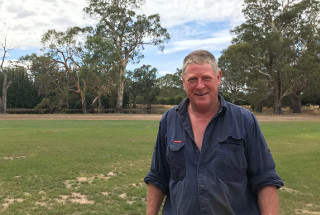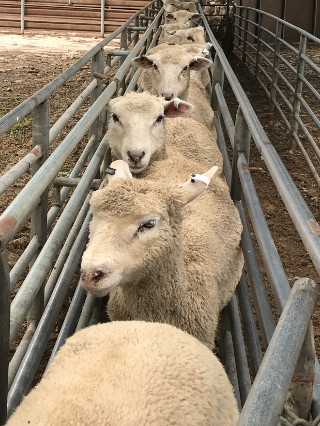Making the tail wag – using lamb carcase feedback

Harrow sheep breeder and feedlotter Richard Edgar wanted to find a way to improve his feedlot operation using electronic ear tags. Richard had used visual tags in the past but identifying individual performance such as the fastest and slowest growing lambs was difficult. He set up a trial, supported by Agriculture Victoria, using 370 ‘tail-end’ lambs from a home-bred mob.
These lambs were the lightest of that year’s wether cohort. All lambs were tagged with electronic tags when they entered the feedlot in late March 2017. The lambs were regularly weighed throughout the feedlot phase. Carcase data was collected and matched back to the ear tag to allow individual analysis.
Using individual carcase feedback
Growth rates in the feedlot varied widely, from 120 to 330g per day, with an average for all lambs of 192g per day. It is recommended that lambs in a feedlot should gain at least 300g per day to be profitable.[1] In general, growth rates were lower than this target, with only 8% of the lambs averaging more than 250g per day of growth.
Richard’s regular weighing and his high-volume production system means that he normally has few problems meeting the specifications of his target markets.
For example, of the mob tracked in this trial, only 3% were outside his target specifications of 24 to 32kg carcase weight. A key learning from Richard’s operation is that high levels of compliance with weight specifications can be achieved if you weigh your lambs and draft them based on target carcase weights before consignment.
Individual carcase weight and fat depth (GR) for the lambs in the consignment are shown in Figure 1. Carcase compliance for weight was high, but there was a large number of lambs with more than 20 mm of fat at the GR site.
Whilst fat is not currently an issue for this market specification it shows that lambs were converting feed into fat rather than muscle. This is a biologically and economically more costly exercise, because laying down fat uses more grain than laying down muscle.
Assessing the performance of his lambs both during the feedlot finishing phase and in the processor’s chiller has given Richard some clear areas where he can improve performance. Importantly, growth rates were below the target, and the high carcase fat depths are likely to have reduced both animal efficiency and economic returns.
Slower-growing, overfat lambs – what’s going on?
Several factors may lead to slower-growing, fatter lambs.
Prior nutrition, including backgrounding, might play a part. For example, there is some evidence that animals that have had poor nutrition early on (for example, triplets with less access to milk) have lower yield and lay down more fat later.
The other big factor to consider is genetics. The use of breeding values is an important tool in ensuring that lambs have high growth potential, and that they are growing when you need them to — either pre- or post-weaning. Breeding values are useful both for selecting animals with good growth, and for ensuring appropriate fatness and muscling.
The use of breeding values is an important tool in ensuring that lambs have high growth potential.
As these lambs were tail-enders, we know that they were the lightest and potentially slowest-growing lambs from that year’s drop. This is reflected in their slower growth rates and may help explain the high fat scores. Compared with faster-growing lambs, slower-growing lambs will be older or more mature when they reach any given weight. This means that, by the time they reach a live weight of 35kg, they may be several months older than the faster-growing lambs.
Lambs lay down proportionately more fat as they mature — so older lambs will grow more slowly and lay down more fat. Richard didn’t collect information about the lambs before they entered the feedlot, but their age or maturity, along with their genetics, birth status and nutritional background, may have led to their sub-optimal performance in the feedlot.
Where to from here?

The trial supplied Richard with some useful information, but not all the answers. The lambs in this case met specifications, but, given their low growth rates and a high level of carcase fat, there is little doubt that the cost to finish these lambs would have been greater than for other lambs. If GR fat depth and/or lean meat yield come into the market specification in the future, Richard may consider other options for these lambs.
More information on the lambs before they entered the feedlot — for example, birth or rear type (twin or single), whether they were born early or late in the lambing period, or dam or sire information — may help to identify the cause of their performance and allow some different management decisions. Entry weight into a feedlot alone doesn’t tell us a lot about the lambs’ growth potential.
There is a big difference between a 33kg lamb at feedlot entry who was a twin born on the last day of the lambing period and a 33kg lamb who was a single born on the first day of lambing — these two lambs might have the same weight at a time point but grow at very different rates.
Because Richard also buys in some lambs, sire genetics and previous feeding information may also help to identify a cause of performance during finishing. By collecting useful data, Richard has the option of feeding some lambs and selling others, depending on background information. The more information that is collected over time, the better the knowledge about what triggers are linked to a lamb’s ability to finish within the preferred time frame.
The more relevant information that is collected, the more informed Richard will be when making decisions about his business.
Lessons learned
- Look at carcase feedback. Richard’s lambs have excellent compliance with weight specifications, but individual carcase feedback can help him to find ways to make his system more efficient. The fat scores, along with the growth rates of the lambs on feed, highlight some areas that Richard can explore to make sure that his tail-end lambs are managed in a profitable way.
- Try to work data collection activities into work that you will already be doing. For example, Richard was already weighing his feedlot lambs on a regular basis, so it wasn’t extra effort to record their weights using eID tags at the same time.
- Work out what you want to achieve, early on. It’s easier to decide what data to collect and how to use the data if you know what you want to improve. Good, consistent data collection protocols mean that more informed decisions can be made.
Making the tail wag
Every sheep producer will have a tail to their lamb drop — the lambs that were born later, or grow slower, so they are too light to sell with the majority of the mob. Richard decided to feed his tail-end lambs to reach a heavy weight market specification. Knowing that most of these lambs grew quite slowly and were considerably fat at the target weight suggests that these lambs possibly should have been sold earlier. Richard can consider more profitable strategies for dealing with the tail in future years. Look at the options and work out which method is the best for that mob, at that time, in that market.
Tools and resources
As trade stock come onto the market from dry areas, farmers have been looking at opportunities to use failed crops or other fodder options to add value or finish stock. Given the variability of lambs to grow well on good feed, and the high cost of supplements, it is worth doing your homework and some sums before embarking on an expensive exercise.
Feedlot calculator developed by the NSW Department of Primary Industries as a useful tool to accurately predict profitability for feed lotting and which brings together all the key factors for making a lamb feedlot a successful enterprise.
Read the Victorian Grazing and Intensive Animal Production Guidelines.
Additionally, Agriculture Victoria has detailed information about everything to consider when thinking about starting or re-evaluating a lamb feedlot.
[1] Meat & Livestock Australia (2007). A producer’s guide to production feeding for lamb growth, Meat & Livestock Australia, North Sydney.
